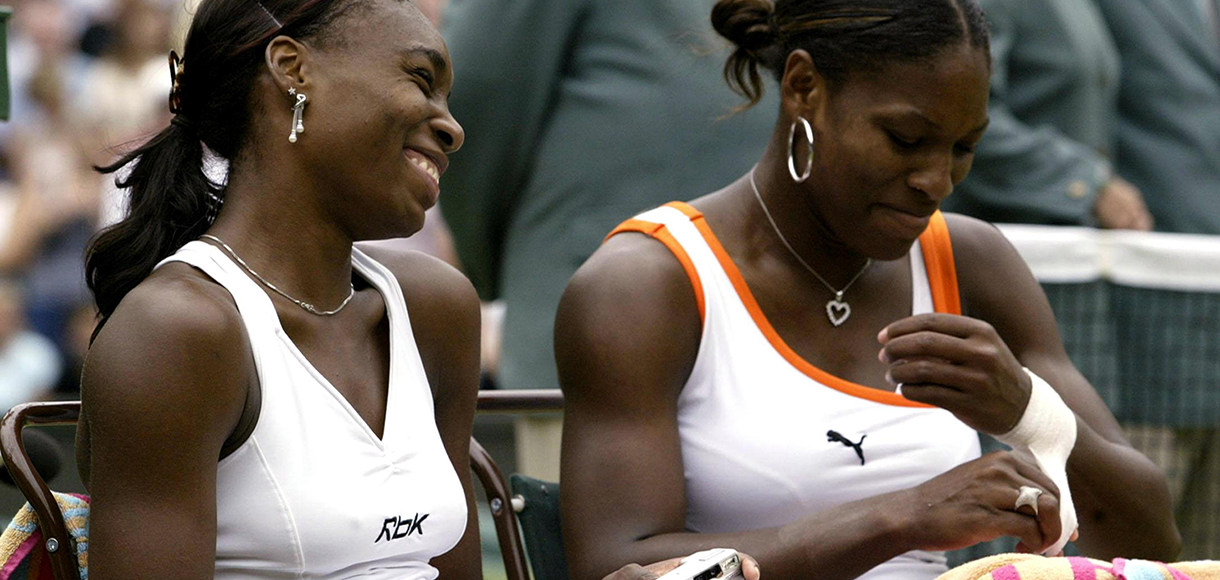Top 10 Australian Open Women's Finals of all time
 Source: Alamy Stock Photo
Source: Alamy Stock Photo
We remember when Serena Williams, Martina Navratilova, and Jennifer Capriati reigned in Melbourne. Ranking the 10 greatest women’s singles finals in Australian Open tennis history.
Tennis fans are ready for the 2024 Australian Open women’s singles tournament. Will Iga Swiatek return to the top of the tennis world? Will defending champion Aryna Sabalenka repeat? Does Naomi Osaka have a comeback in her?
Before getting too far into this year, let’s take a moment to look back at the 10 Greatest Australian Open women’s singles finals of all time.
When is the 2024 Australian Open Women’s Final?
The 2024 Australian Open women’s singles final will be played on Saturday, Jan. 27.
What time is the 2024 Australian Open Women’s Final?
The 2024 Australian Open women’s singles final will be played on Saturday, Jan. 27, at 7:30 p.m. (3:30 a.m. ET in the United States)
Australian Open Women’s Finals History
Interested in learning some Australian Open women’s finals history? The first women’s Australian Open champion was Margaret Molesworth back in 1922. The most recent winner was Aryna Sabalenka in 2023. The most frequent winner was Margaret Smith Court, who has the most all-time titles with 11. American Serena Williams has the most titles in the post-1968 “Open Era” with seven.
A complete list of Australian Open women’s winners can be found here.
Who has won the most Australian Open women’s titles?
Margaret Smith Court has the all-time record for most Australian Open titles with 11, and Serena Williams has the most in the post-1968 “Open Era” with seven.
Ranking the Top 10 Greatest Australian Open Women’s Singles Finals of All Time
- No. 5 Aryna Sabalenka defeats No. 22 Elena Rybakina in 2023
Match Result: 4-6, 6-3, 6-4 (10)
We’ll kick off our list with the most recent women’s Australian Open final, in which Belarus’ Aryna Sabalenka claimed her second career Grand Slam event title. Sabalenka stood tall up until the final: The No. 5 seed didn’t face any other top 10 seeds, nor did she lose a single set through the semis.
Her opponent in the final was No. 22 seed Elena Rybakina, who snatched the first set to put Sabalenka in an unfamiliar position. The Belarusian battled back and claimed the second set before evening the score at 3-3 in the third. She then broke Ryabkina to go ahead 4-3 and never looked back.
Sabalenka is among the women’s betting favorites at the 2024 Women’s Australian Open.
- No. 1 Serena Williams defeats wild-card entry Justine Henin in 2010
Match Result: 6-4, 3-6, 6-2
Yes, you read that correctly. Former world No. 1 Justine Henin made it into the 2010 Australian Open women’s singles draw as a wild-card entry. She had retired in 2008 before announcing a return to the tour in 2010, and the Australian Open would be her first Grand Slam tournament in two years.
Naturally, Henin didn’t miss a beat and plowed into the finals, shocking world No. 5 Elena Dementieva in the second round. Her opponent in the final, world No. 1 Serena Williams, was the reigning Australian Open champion and fresh off a three-set thriller over Victoria Azarenka in the quarterfinals.
Henin, herself a 2008 Australian Open finalist and 2004 champion, split the first two sets with Williams. The American then buckled down and pulled away in the third set, ending Henin’s fairytale run.
“I had my opportunities but it's been almost perfect, just the last step I couldn't make it,” Henin said.
- No. 1 Daphne Akhurst defeats No. 4 Sylvia Harper in 1930
Match Result: 10-8, 2-6, 7-5
The Australian Open women’s trophy is named after legendary Aussie tennis star Daphne Akhurst because of her performance in matches such as this one. The No. 1 seed was not only the two-time defending champion and winner of four out of five previous tournaments heading into 1930, she was also already a four-time women’s doubles winner (she’d win one more) and four-time mixed doubles champion. This was her competition to lose.
In an era before tiebreaks, Akhurst survived a 10-8 first set against fellow Australian Sylvia Harper in the first round before dropping the second set 2-6. With the third tied at 5-5 and another lengthy set looming, Akhurst wrapped up the win with a 7-5 finish.
- No. 4 Naomi Osaka defeats No. 8 Petra Kvitova in 2019
Match Result: 7-6 (7-2), 5-7, 6-4
The 2019 Australian Open completed Naomi Osaka’s reputational shift from that of plucky outsider to one of the best players of her era. The Japanese star had never even cracked a major semifinal before storming to victory at the 2018 U.S. Open, and she was looking to become the first woman to win consecutive Grand Slam tournaments since Serena Williams in 2015.
Osaka was well out ahead of her Czech opponent, eighth-seeded Petra Kvitova, leading 5-3 and 40-0 in a potentially decisive second set. But Kvitova stormed back, won the set, and evened the score at 3-3 in the third. Osaka finally maintained her composure to get over the finish line and clinch her second Grand Slam event title, explaining: “It’s one of those moments where you are fighting so hard and then when it’s finally over, you’re still in the state of competition.”
- No. 12 Jennifer Capriati defeats No. 1 Martina Hingis in 2001
Match Result: 6-4, 6-3
The 2001 Australian Open women’s final isn’t on this list because it was a particularly thrilling match. Indeed, American Jennifer Capriati dispatched Swiss star Martina Hingis in straight sets. This match makes the list because it saw Capriati clinch her first career Grand Slam tournament title and complete a beautiful redemption story.
Capriati was a semifinalist at the 1990 French Open as a 14-year-old and one of the sport's best players until 1993, when she took a break from the tour. She struggled with her comeback but slowly gained momentum and stormed to the 2001 Australian Open final. Her opponent was world No. 1 Martina Hingis, already a three-time Australian Open champion, who was appearing in her fifth straight final.
Capriati raced to an early 4-0 advantage and never looked back. In the process, she became the lowest-ever seed (No. 12) to win the Australian Open women’s singles championship.
- No. 1 Monica Seles defeats No. 2 Steffi Graf in 1993
Match Result: 4-6, 6-3, 6-2
The 1993 women’s Australian Open finale checked off every box necessary for a legendary championship match. Consider what it had:
- Elite players: Monica Seles was the world No., 1, and Steffi Graf was the world No. 2. They were arguably the two best players of their era.
- Rivalry: Seles and Graf had played each other in two 1992 Grand Slam tournament finals, splitting the pair.
- Stakes: Seles was sitting on two career Australian Open titles. Graf already had three.
- Length: The match went three sets with Seles winning the final two to equal Graf’s three career Australian Open titles.
- No. 3 Martina Navratilova defeats No. 1 Chris Evert in 1981
Match Result: 6-7 (4-7), 6-4, 7-5
Speaking of rivalries, let’s now look back to the best head-to-head rivalry of the 1980s. The 1981 women’s Australian Open final between No. 3 Martina Navratilova and No. 1 Chris Evert had many of the same elements as the 1993 Seles-Graf match, as well as a bit more length.
This match was played relatively early in the American tennis stars’ rivalry, and neither had previously won an Australian Open final. They both played desperately, and the match saw the most points ever played in a women’s singles final during the Open Era. Evert’s first-set tiebreaker victory was not enough, however, as Navratilova broke in the second and third sets at just the right time to claim early bragging rights in what became a longstanding rivalry.
- No. 2 Chris Evert defeats No. 1 Martina Navratilova in 1982
Match Result: 6-3, 2-6, 6-3
No, you’re not seeing double. There was a second straight Evert-Navratilova women’s final at the 1982 Australian Open. This second match did not last as long nor offer the same level of novel excitement as the first one, but it was the tournament’s first finals rematch of the Open Era.
It was also the moment for Chris Evert to win her first Australian Open. The American tennis legend was already a four-time French Open champion, three-time Wimbledon winner, and five-time U.S. Open titlist. Australia was the only major she was missing, and she got the job done against her longtime rival.
- No. 1 Jennifer Capriati defeats No. 3 Martina Hingis in 2002
Match Result: 4-6, 7-6 (9-7), 6-2
There is no shortage of rematches on this list. Our No. 6 match was the one in which 12th-seeded Jennifer Capriati upset world No. 1 Martina Hingis to claim the 2001 Australian Open title. Incredibly, those two would meet again one year later. This time around, Capriati held the world No. 1 ranking after a year in which she had reached four Grand Slam tournament semifinals.
Hingis was playing in her sixth-straight Australian final, although she had lost her last two title matches. In fact, she had lost in the finals of four consecutive Grand Slam events and was looking to turn the tide against the woman who had shocked her the previous year. However, her revenge was short-lived. Hingis’ first set victory was washed away by a heartbreaking, lengthy tiebreaking defeat in the second.
In the scalding Australian heat, Hingis folded and lost the final set 6-2.
“After I lost the second set, she (Capriati) had the momentum,” said Hingis. “I didn't really believe in it anymore, even when I was up, 2-1. I knew I probably wouldn't last if I really needed to, so I just tried to walk through it. But I had goosebumps all over my body. It was just dehydration."
- No. 1 Serena Williams defeats No. 2 Venus Williams in 2003
Match Result: 7-6 (7-4), 3-6, 6-4
The 2003 Australian Open women’s singles final had literally everything you could want in a match. Consider all the drama around the tournament that year:
- Two-time reigning champion Jennifer Capriati was upset in the first round.
- World No. 1 Serena Williams was coming off three straight major victories in 2002 and needed only an Australian Open championship to complete a career Grand Slam.
- Serena’s sister, Venus. was a four-time Grand Slam event winner looking to be No. 1 again.
- It was the first Grand Slam event championship match in which Serena and Venus faced each other (they would go on to meet on nine more occasions).
"I never get choked up, but I'm really emotional right now,” she said after the match, which saw her survive three close sets for a grueling victory and a huge moment in her career.
Parameters of Rankings
These rankings are based on the performances of each player involved, each player’s tennis legacy, the length of the match, and the match’s significance in Australian Open history.
Australian Open Tennis Betting Odds at Betway
Find Australian Open odds on the Betway. You’ll find all the latest spreads, totals, money lines, and tip-offers. Missed tip-off? No problem, Betway also offers live betting. All your Tennis betting needs are covered at our online sportsbook.
Visit Betway’s Tennis predictions page for the best insights, analysis, and picks on futures, parlays, props, and more.
























